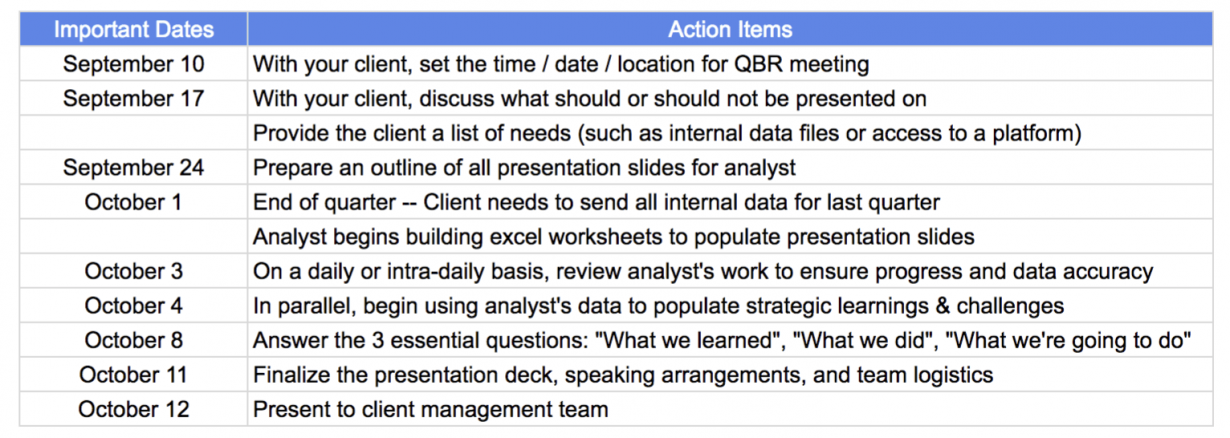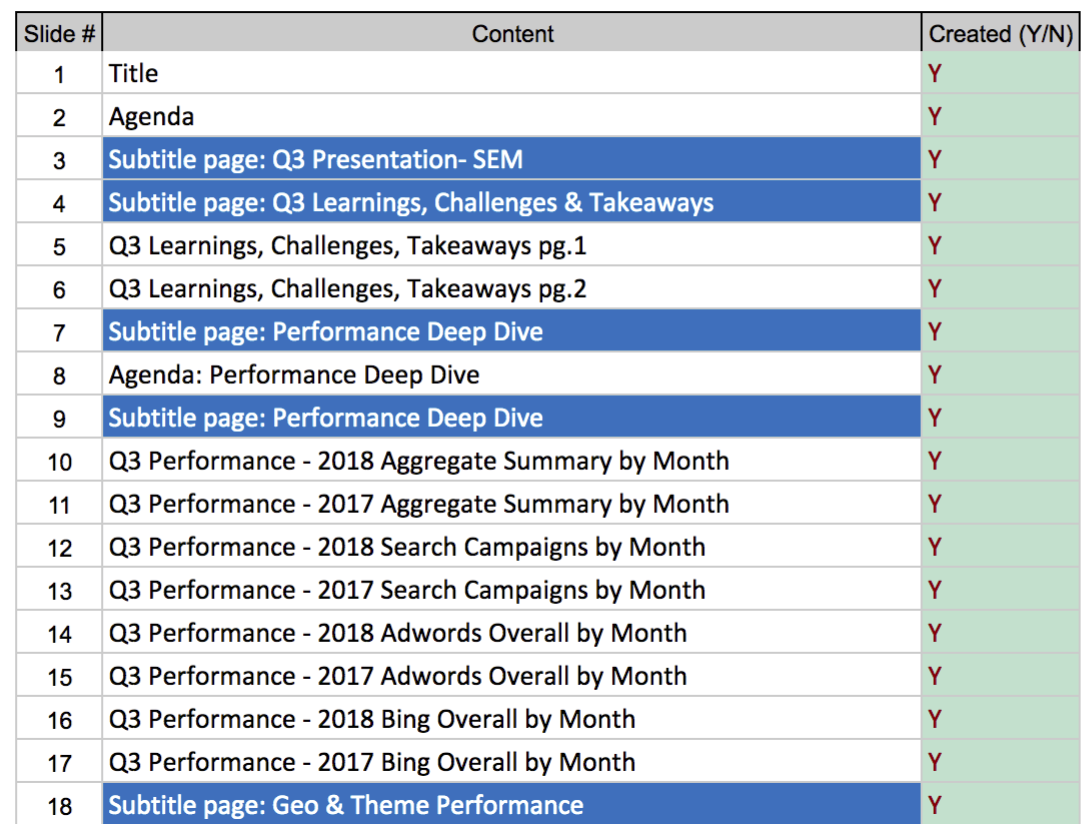After conducting my 17th Quarterly Business Review (QBR) in the past 2 years, it seemed like a good time to recap the dos and don’ts we’ve learned along the way.
This guide distills some helpful best practices for ideating, preparing, and presenting your Quarterly Business Review to company executives and other stakeholders.
GET THE TEMPLATE
What is a Quarterly Business Review?
Quarterly Business Reviews (QBRs), sometimes called Executive Business Reviews (EBRs), are a once-per-quarter meeting with the executive team and other stakeholders to discuss strategic initiatives, macro-level trends, and return on investment (ROI) of their marketing dollars. This is best delivered as an on-site presentation where your teams can meet face-to-face to discuss these three essential questions:
- What did we learn this quarter?
- What did we accomplish this quarter?
- What are we going to accomplish next quarter?
In the world of performance marketing, you’re only as good as your last quarter. These critical quarterly meetings help foster relationships and ongoing partnerships. A QBR is also an opportunity to get recognition and visibility for your hard work, results, and strategic vision over the entire quarter. There are a lot of moving parts and different angles to consider when preparing a QBR presentation. This guide will help you think through the various elements of a QBR to ensure that you are set up for success. Let’s get started.
The QBR Ideation & Brainstorm Process
A lot happens over the course of three months, especially in the world of digital marketing. You’ve probably been focusing on building, optimizing, and scaling various marketing platforms on a daily basis. You may be having weekly calls to review performance, current tests, upcoming initiatives, and troubleshoot challenges that arise.
The rest of your time is probably divided between internal meetings, partner meetings, events, and deep industry research. Needless to say, when you finally pick your head up from 90 days of intense work, it might be difficult to see the big picture.
The first step in the Quarterly Business Review is to take a step back, breathe, and make a plan. Start by outlining each step of the process that needs to occur prior to your presentation.

Throughout this process you should be thinking about the audience for your QBR presentation. It’s critical to understand who will be there, where they sit in the hierarchy of the company, how to structure your presentation for them, and how to prepare answers to their questions beforehand. In short, you need to think like a marketer.
Let’s take a look at some likely members of that group and what they care about:
- Chief Executive Officer (CEO) / Company President: High-level, macro view of their industry and business. Their focus may be on outside-the-box growth ideas, P&L (profit & loss) scenario analysis, or a focus on what competitors are doing that their business is not.
- Chief Marketing Officer (CMO) / Vice President (VP) of Marketing: Creates the yearly marketing plan that sets your monthly budget. They have a high-level focus on all marketing partners and channels, but will know your top-line numbers prior to your presentation. They will be interested in overall learnings from your testing data and big upcoming initiatives and strategy.
- Director of Marketing / Marketing Manager: Helps set strategy, allocating additional budget between the channels, and in the weeds with you on a daily or weekly basis. Your goal will be to align the focus of your QBR presentation with the discussions you’ve had throughout the quarter, as well as understanding the bigger picture around prioritization.
During the brainstorm process, ask yourself how well you know the business. Think outside the scope of your particular vertical and consider the entire business, each business unit, overall product roadmap, funding news, and competitive industry trends.
Take advantage of the time with senior executives during the QBR presentation to ask questions about these topics.
The QBR Data Preparation Process
Your Quarterly Business Review presentation needs to feature accurate and transparent data. Once again, your first objective in the data preparation process should be to build a comprehensive list of slides that you’ll be presenting.
Given the breadth of data and the ability to segment by many subsets of data, having a list of all of the necessary slides will keep you focused on any remaining tasks and keep you accountable to your timeline. You should find yourself adding and removing slides in your outline as necessary and communicating with your team on the presentation flow. Included below is a snapshot of the first 20 slides in my recent QBR:

In the performance marketing world, QBRs usually require aggregating platform data and merging it with internal client data and industry data, which is always time-consuming and laborious no matter how streamlined your system is. However, after presenting more than a dozen QBRs, I firmly believe that the success of a QBR presentation can be directly attributed to the meticulous and diligent processes during this data phase, so it’s important not to skimp.
You need to be very familiar with the relevant data when you present, so the work you’re putting into this preparation will pay dividends. Analyzing the data forces you to understand and become an expert on every number.
Additionally, it’s also extremely important to be transparent. It’s okay to have initiatives that are underperforming. Don’t attempt to hide poor-performing initiatives. The QBR is the platform to have strategic discussions about underperformance and to take accountability for objectives that were missed, not to hide errors or interfere with the transparency of your data.
The QBR Presentation
Presenting is actually a bit of a misnomer here: your end goal is to tell the story of the past quarter.
During both the brainstorm and data preparation phases, you’ve been figuring out what’s important: you’ve developed your internal timeline & plan, outlined every slide to aggregate data and present on, and put together what matters to each client participant. So how do you tie it all together and develop the story?
There is no one-size-fits-all story when it comes to a QBR. A great starting point is to have your director or manager review the completed presentation and poke holes in each slide.
Generally, our internal QBR slides usually have one part data (in a table or graph form) and one part takeaway (as a highlight or lowlight). With the takeaways you can drill down into the “why?” or the “so what?” and continue to iterate until you’ve arrived at the underlying insights.
Once you’ve determined what the ‘story’ is, you should ensure that your team knows what role they will play in the presentation. Who is leading? Who is presenting on specifics or helping to field questions about particular initiatives? Who is taking notes? Figure all of that out ahead of time
Don’t overcomplicate the presentation. You’ve gone to great lengths to prepare an amazing presentation and because you’ve waded through dozens of pivot tables, you have each datapoint buzzing around your head. You are over-prepared and that should calm your nerves.
Walk through each slide in the presentation as you tell your cohesive story. Confidence is key here and your expertise and preparation should give you that confidence. Give your audience time to digest each slide and talking point. Expect lots of questions throughout your presentation. A great QBR presentation balances the prepared narrative with the questions and discussion prompted by the presentation. Just be sure to keep things on track as these discussions can derail your presentation flow and timing if you don’t manage them properly.
While your performance data is table stakes (remember: you’re only as good as your last quarter), your audience will likely care most about what you’re planning and committing to accomplish next. This may mean course-correcting poor performance or it could mean working to make the next quarter even better. What is your plan to do that?
There are a few strategies for discussing future initiatives during your QBR:
- List out all the initiatives that you’ve discussed throughout the quarter. Then you can look at your previous QBR decks and add in past initiatives that were not accomplished. This will get you a quick, but dry list of ideas that may move the needle for your client.
- Create a list of the most impactful forward-looking ideas and strategies for your client. This tends to be the better, more thorough plan of attack. Look to utilize your industry expertise in the context of your client’s business, technological ability, season, and sector. Rank these ideas in order of impact.
Your time to discuss each idea here should be limited by the size of the opportunity. You should frontload the biggest opportunities for their business so that you have the most time to discuss these ideas during the QBR.
You should also listen: learn more about other business units, strategies, and internal challenges. Bounce ideas off of senior-level executives and have a thoughtful strategic back-and-forth. In my experience, you come out of these meetings with about 1-3 big ideas and 3-5 small ideas. It’s your job to go and execute on them for the following quarter.
Tips to Avoid QBR Failure
Since we’ve discussed all the ways to ensure you have a successful QBR, here are also a few tips to avoid QBR failure:
- Don’t use the QBR as a meeting to troubleshoot minor issues or challenges. The audience for QBRs will vary and will often include executives and other stakeholders who don’t have day-to-day context. These types of conversations should be handled in your normal communication cadence.
- Avoid extensive discussion on negative topics. Have honest and open discussions about challenges, but don’t dwell.
- Don’t blame anyone on your team for underperformance or mistakes. As the person responsible for results and progress, you should take responsibility for anything that went wrong and share all the credit with your team for the things that went right.
A Quarterly Business Review is an opportunity to showcase your team’s hard work and strategic thinking to the various stakeholders from your client’s organization. It’s a great forum to build stronger relationships, collaborate, and cap off the immense effort you’ve made over the quarter.







Responses